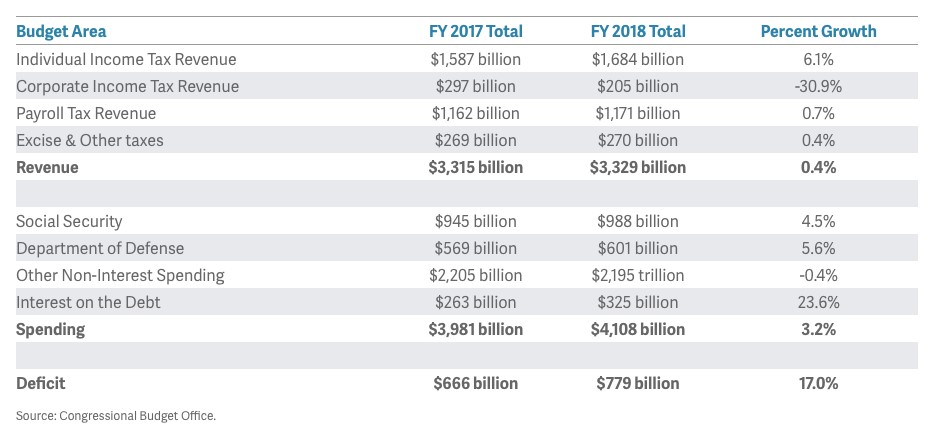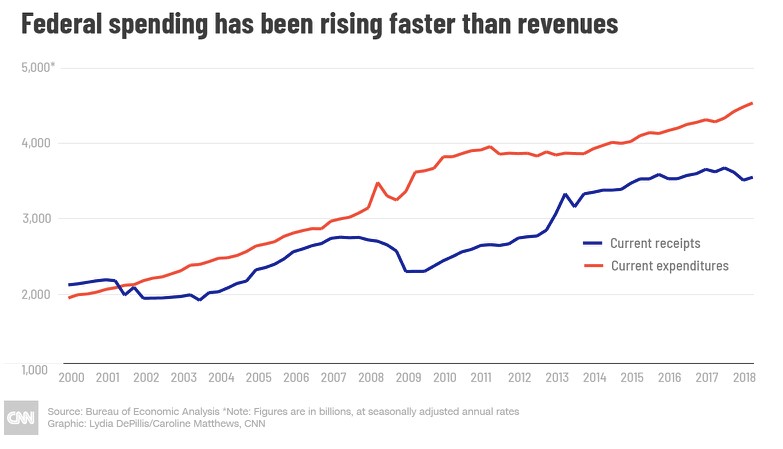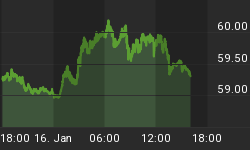Despite a growing economy, the U.S. deficit has risen 17 percent for the fiscal year ending September 30th, hitting $779 billion. This is the highest level since 2012, when it hit $1 trillion—but in the aftermath of a recession.
This year’s excuse doesn’t include recession damage control. In fact, it somehow includes the backdrop of a stable economy, with record-low unemployment, modestly rising wages and inflation that’s mostly under control.
So while economic growth usually leads to higher tax revenues and higher household income, which in turn enables more government spending and lower deficits, 2018 is defying the trend.
According to the U.S. Department of Treasury, tax cuts mean revenue cuts that coincide with higher government expenses coupled with new government spending under Trump’s first full-year budget.
The Treasury Department data showed that while government receipts were flat from last year to this year, corporate tax collections fell 22 percent, by $76 billion, which was in turn offset by increased revenues from individual and self-employment taxes.
There was also a registered 35-percent revenue increase for the month of September 2018 from “excise, customs and other” sources possibly attributed to new tariffs.

(Click to enlarge)
But the overall picture is one of spending rising faster than revenues, though. Spending rose 3 percent on the fiscal year, with more defense spending and increases in social security and federal debt interest. Related: Stocks Continue To Slide As Economic Fears Fester
In a chart put together by CNN, it looks something like this:

(Click to enlarge)
And the big picture comes into clearer focus when you look at the “real” debt numbers—not just the deficit.
The deficit is the difference between government spending and revenue collection. Debt is what the government has to borrow to cover years of budget deficits.
Total U.S. debt rose to $21.456 trillion by the end of this fiscal year—up from $20.244 trillion for the previous year. The $779 billion figure excludes deb the U.S. government owes to government agencies, according to columnist John Crudele, writing for the New York Post. The real total debt figure includes a $1.21-trillion increase, and one the biggest collector is social security, while around half of the debt is held by countries such as China, Japan and Saudi Arabia.
Speaking about deficit rather than total debt, Michael A. Peterson, Chairman and CEO of the Peter G. Peterson Foundation, told Crudele that this is “just the beginning of large and growing deficits as far as the eye can see”.
Related: Retail Sales Rebound, But Is It Enough To Post Positive Earnings?
He also called this “historically high” and “dangerous”, noting that it’s a “reflection of just how irresponsible our budget policies have become”.
At the end of the day, it could harm the economy by driving up interest rates and slowing economic growth—all of which trickles down to lower living standards for Americans, according to Maya MacGuineas, president of the nonpartisan Committee for a Responsible Federal Budget.
And in terms of the Treasury Department’s deficit report, CRFB notes that the deficit “would be even larger if it weren’t for a quick of the calendar”. The Committee said that the data only accounted for 11 monthly benefits payments instead of 12, which would have put the deficit at around $820 billion.
The Committee wastes no time in blaming legislation for the deficit increase, noting that the CBO itself estimated that the tax law would cost $164 billion in this fiscal year, “accounting for more than the entire deficit increase”.
By Fred Dunkley for Safehaven.com
More Top Reads From Safehaven.com:

















